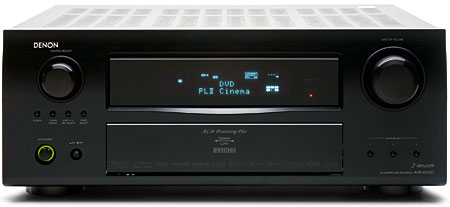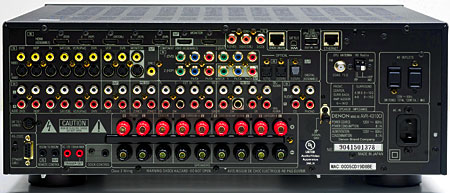Denon AVR-4310CI A/V Receiver
 Price: $1,999 At A Glance: First receiver with Audyssey DSX width and height channels • Anchor Bay video processing • Napster, Rhapsody, and numerous other streaming features
Price: $1,999 At A Glance: First receiver with Audyssey DSX width and height channels • Anchor Bay video processing • Napster, Rhapsody, and numerous other streaming features
Should You Go Wide?
Surround sound is fully half of the home theater equation. Like any technology, it presents certain complexities, and mastering at least a few of them will reward the patient listener. However, surround almost makes a fetish of complexity. It turns a lot of people off, which inhibits its household penetration. It also puts a technology critic like me on the spot when I take keyboard in hand to tell you about the Denon AVR-4310CI A/V receiver, with Audyssey’s DSX, which introduces a new complexity: width channels.

What is my role here? Am I the knowledgeable friend who leads you through the briar patch with as few scratches as possible? Am I the puppet master who says a thundering yea or nay to this new width-channel technology? Am I the ink-stained wretch who gets a salary and health insurance to write about this stuff and is grateful for it? Am I a sinister enabler for the three main licensors of surround technologies—in this case Audyssey, but also including Dolby, DTS, and HX—as they push to get their logos onto surround products and their licensing fees out of manufacturers? Am I part of the solution or part of the problem?
The answer is that I inhabit all of these roles, and comfortably for the most part, although the last question troubles me. I’ve explained multichannel audio technologies for multiple decades. I know that many people who read my explanations will either shun A/V receivers or connect two speakers to them because understanding the technology is too onerous. Every chance I get to add another chapter to the history of surround makes people even less likely to read the book. But if we knowledgeable friends, puppet masters, ink-stained wretches, and sinister enablers had never taken this leap of faith, the magic of your big screen would still be undermined by mediocre TV speakers. So, as Shakespeare said, once more into the breach, dear friends.
Beyond 5.1, Via Audyssey
Audyssey’s founders are R. Tomlinson Holman and Chris Kyriakakis, both professors at the University of Southern California and formidable experts on all things surround. (T. Holman is, by some explanations, the TH in THX.) In A/V receivers, the company is best known for its auto setup and room correction technology, which I can say without fear of hype is the class act of the field. The version included in this receiver is Audyssey MultEQ XT, which allows the setup microphone to take measurements from up to eight listening positions. If a custom installer sets up the product, make that 32 positions. The Denon also includes two Audyssey listening modes—Dynamic Volume and Dynamic EQ. They adapt dynamically ferocious movie soundtracks for lower-volume listening by normal people in normal homes. But my chief obsession in this review was Audyssey DSX—or Dynamic Surround Expansion—the first modern surround technology to add width channels.
DSX offers a choice of two enhancements: width or height. Audyssey isn’t the first licensor to offer a height enhancement—Yamaha has offered its proprietary solution for years, and Dolby recently beat it to the punch with Pro Logic IIz, which made its debut a few months ago in the Onkyo TX-SR607. The puppet master in me has been quoted as saying that height (in the DPLIIz version) is “transformative” for movies but “not as striking” for music.

In a receiver like the Denon, with seven amp channels, you have a choice of three enhancements: width, height, or back-surround. DSX Width and DSX Height are both post-processing listening modes. In other words, they don’t exist in the form of specifically encoded software—DSX derives new channels from existing software. In contrast, back-surround channels can be derived from existing material upon playback or pre-encoded into software and decoded on playback. However, where back-surrounds are concerned, the knowledgeable friend in me has always forcibly restrained the sinister enabler—I think most home theaters can do without ’em.
Audyssey says that the most helpful enhancement is width, followed by height, followed by back-surround. In theory, all three can run simultaneously. If manufacturers follow through with 9.1-channel AVRs, which Denon has hinted at doing, you’d have a choice of two out of the three.
Why width? Audyssey says: “Research in human hearing shows that we can hear many more directions than what current systems provide. Experiments have shown that human localization is better in front than to the sides or behind. This means that for front-weighted content such as movies and most music, good engineering dictates that we employ more channels in the front hemisphere than the back. Imaging is also better horizontally than vertically, and so good engineering also dictates that channels must first be added in the same plane as our ears before going to higher elevations.”
Audyssey recommends that you place the front left and right speakers 30 degrees off center, the height speakers 45 degrees out and 45 degrees up, the width speakers at 60 degrees, and the side-surrounds at 120 degrees. This puts the width speakers about halfway between the front center and side-surrounds.
Be warned that getting the width speakers into the correct positions may be devilishly inconvenient—it was in my room. Audyssey recommends that you place all five of the front speakers in an arc. This is hard enough to do with three front speakers (my usual practice). With a total of five, and the width speakers at the recommended 60-degree offset from the front center, the width speakers encroach on the sides of the room and come nearer to the seating area. In addition to at least two more speakers and their cabling, you’ll also need some real estate to make it work.
























































